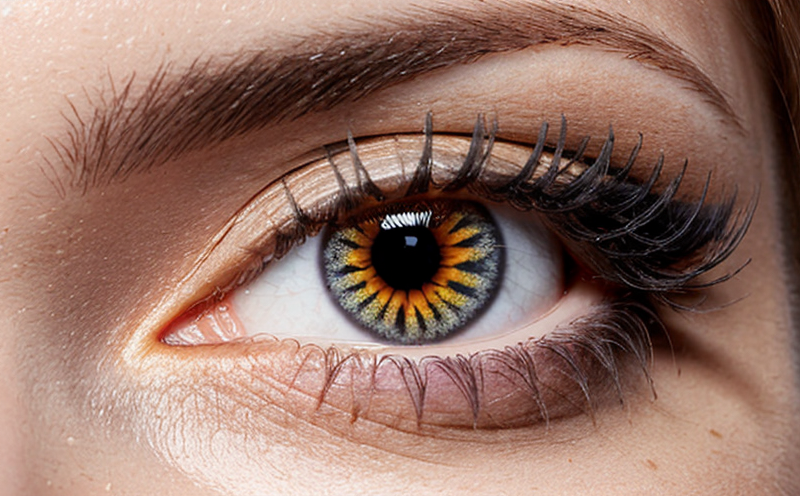Repeated Application Ocular Safety Testing in Cosmetics
The repeated application ocular safety testing in cosmetics is a critical evaluation of cosmetic products to ensure they are safe for human use. This test evaluates the potential irritation or damage caused by prolonged and repeated contact with the eyes over extended periods. The primary focus is on identifying any adverse effects from repeated daily use, which is more representative of real-world usage compared to a single exposure.
Understanding the ocular safety testing process involves several key steps that ensure comprehensive assessment. Specimens are selected based on their intended use and formulation. Preparing these specimens correctly is crucial for accurate test results. This includes ensuring the product's integrity, stability, and homogeneity before application.
The methodology typically follows international standards such as ISO 10993-11:2015, which provides guidance on biocompatibility testing of medical devices and their components. For cosmetics, this is supplemented by additional guidelines like ASTM F801:2016 for ocular safety evaluation.
During the test, participants apply the cosmetic product to their eyes daily under controlled conditions over a specified period. This might be for up to 30 days or more, depending on the specific requirements of the standard being followed. The frequency and duration of application are carefully designed to simulate real-world usage scenarios.
Following each application, participants undergo detailed assessments by qualified medical personnel. These checks include visual examinations using slit lamps, fluorescein staining, and other diagnostic tools to detect any signs of irritation or damage. Keratitis, corneal abrasions, conjunctival hyperemia, and other potential ocular issues are closely monitored.
The data collected from these assessments is analyzed meticulously to determine the product's safety profile. Statistical methods may be employed to identify trends or patterns in the observed effects. This information helps manufacturers make informed decisions about product formulation and labeling.
Results of repeated application ocular safety tests can significantly influence regulatory compliance, consumer trust, and market acceptance. Compliance with these rigorous testing protocols ensures that products meet stringent safety requirements set by various global regulations including those from the European Union (EU) and the United States Food and Drug Administration (FDA).
- ISO 10993-11:2015 - International Organization for Standardization
- ASTM F801:2016 - American Society for Testing and Materials
This testing process not only protects consumers but also helps companies develop safer, more reliable products. By adhering to these stringent standards, laboratories play a vital role in ensuring the integrity of cosmetic formulations.
Scope and Methodology
The scope of repeated application ocular safety testing is broad yet specific, focusing on evaluating the long-term effects of cosmetic products on eye health. It encompasses a wide range of product types such as mascara, eyeliner, eyeshadow, and other items that might come into frequent contact with the eyes.
- Specimen Preparation: Ensuring specimens are in their intended form before testing begins
- Application Frequency: Daily application for extended periods to simulate real-world use
- Evaluation Criteria: Visual examinations using slit lamps, fluorescein staining, and other diagnostic tools
The methodology involves careful selection of participants who reflect the target consumer demographic. They undergo thorough training on how to apply the products correctly according to the test protocol. This ensures consistent application across all subjects participating in the study.
Data collection is comprehensive, capturing not only immediate responses but also long-term effects. Participants are monitored closely for any adverse reactions or changes in eye health throughout the testing period. Regular follow-up visits allow for detailed assessment and documentation of outcomes.
The results from these tests form a crucial part of the product development process. They guide manufacturers in refining formulas, adjusting ingredients, and enhancing overall safety without compromising efficacy. Compliance with these standards enhances brand reputation and fosters consumer confidence.
International Acceptance and Recognition
- ISO 10993-11:2015 - Biocompatibility Testing of Medical Devices
- ASTM F801:2016 - Ocular Safety Evaluation for Cosmetics
- European Union (EU) Regulation 726/2004
- FDA Cosmetics Regulations and Standards
The repeated application ocular safety testing in cosmetics enjoys widespread international acceptance, with standards recognized by regulatory bodies around the world. The European Union's Cosmetics Regulation (EC) No 1272/2008 mandates adherence to such tests for certain categories of cosmetic products. Similarly, the United States Food and Drug Administration (FDA) requires similar evaluations as part of its stringent safety regulations.
Recognizing the importance of these tests, regulatory authorities from various countries have harmonized their approaches to ensure consistency in product safety assessments across borders. This alignment facilitates easier compliance for manufacturers operating internationally. Laboratories accredited by bodies like the International Laboratory Accreditation Cooperation (ILAC) and recognized by organizations such as the Good Laboratory Practice (GLP) provide assurance of high-quality testing.
The global acceptance of these tests reflects a shared commitment to consumer safety and product integrity. By adhering to international standards, laboratories contribute significantly to maintaining the highest levels of quality in cosmetic manufacturing processes worldwide.
Environmental and Sustainability Contributions
The repeated application ocular safety testing in cosmetics also has positive environmental impacts. By ensuring that products are safe for prolonged use, manufacturers can reduce the need for recalls or product reformulations due to adverse effects. This minimizes waste associated with defective products reaching consumers.
Furthermore, the rigorous testing process drives innovation towards safer and more sustainable formulations. Researchers focus on developing ingredients that not only meet safety standards but also have minimal environmental impact. The use of biodegradable materials and eco-friendly packaging enhances sustainability efforts further.
Consumer awareness about product safety has grown significantly in recent years, leading to increased demand for transparent labeling and ethical sourcing practices. Laboratories play a key role in supporting these trends by providing data that supports responsible manufacturing decisions. This contributes positively to the overall environmental footprint of the cosmetics industry.
The commitment to sustainable practices extends beyond just testing methods; it encompasses the entire supply chain from raw material selection to final product release. By prioritizing safety and sustainability, laboratories contribute meaningfully to a more responsible and environmentally conscious industry ecosystem.





